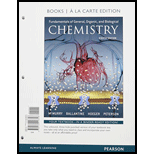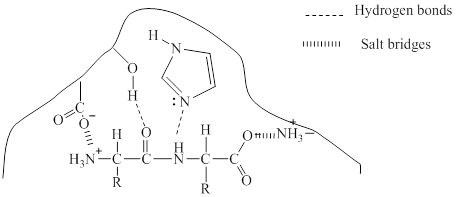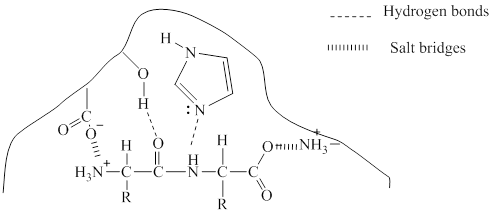
Interpretation:
The two types of bonding which will occur in the bonding of the enzyme-substrate complex should be given with dotted lines.
Concept Introduction:
Enzyme:
- It is a protein or a molecule which can act as a catalyst for a biological reaction.
- Does not affect the equilibrium point of the reaction.
- Active site of the enzyme is the region where the reaction takes place.
- Enzyme’s activity can be specific which means the activity is limited to a certain substrate and a certain type of reaction and it is referred to as specificity of the enzyme.
Hydrogen bonding: It is an unusual strong intermolecular force occurs between a hydrogen atom and an electronegative atom like nitrogen, oxygen or fluorine. It occurs in both water and ammonia
Answer to Problem 19.24UKC

Explanation of Solution
Enzymes are three dimensional molecule with a catalytic site into which the substrate can fit. The enzymes are said to be so specific in their action because the activity is limited to a certain substrate and a certain type of reaction and it is referred to as specificity of the enzyme. It can be said that few molecules have the appropriate shape and
Given in the diagram a dipeptidase enzyme and the substrate to form the enzyme-substrate complex. Different types of bonding may occur between the enzyme and the substrate to form the enzyme-substrate complex.
Hydrogen bonding is the attraction between a hydrogen atom and an electronegative atom and it can be considered as a special type of dipole-dipole interaction. The oxygen atom in the substrate can make hydrogen bond with hydrogen in the enzyme.
Salt bridges are formed between oppositely charged residues that are nearby to experience electrostatic attraction. Here, salt bridge is formed between the anionic carboxylate ion
The bonding is shown below:

The two types of bonding which will occur in the bonding of the enzyme-substrate complex is given with dotted lines.
Want to see more full solutions like this?
Chapter 19 Solutions
Fundamentals of General, Organic, and Biological Chemistry, Books a la Carte Plus Mastering Chemistry with Pearson eText -- Access Card Package (8th Edition)
- The enzyme lysozyme hydrolyzes glycosidic bonds in peptidoglycan, an oligosaccharide found in bacterial cell walls. The active site of lysozyme contains two amino acid residues essential for catalysis: E35 and D52. Which of the following statements about lysozyme is true? More than one may apply The graph shows the pH-activity profile of lysozyme. 100 50 4. 6. 8. 10 pH Residue E35 exhibits general base catalysis O The pKa of E35 is approximately 4.3 O The pKa of D52 is approximately 4.5 O The optimal activity of lysozyme is approximately 5.2 Residue E35 exhibits covalent catalysis The pka of E35 is approximately 6.1 The pka of D52 is approximately 3.7 Activity (% of maximal)arrow_forwardb) Why might the compound shown below act as a transition state analog of phosphoglucose isomerase? A drawing of the normal transition state for this enzyme is needed. HO- OH T .N -OH -OH CH₂OPO₂²-arrow_forwardThe total concentration of enzyme in a reaction, [E], is made up of the concentration of enzyme bound to substrate, [ES], and the concentration of enzyme still free in solution, [Ef]. Similarly, the total amount of substrate is made up of [Sf] and [ES]. We can assume that the concentration of enzyme is much less than that of the substrate, [E] << [S]. Assuming the steady state condition and the relationships between [E], [Ef] and [ES], and similar ones for S, given in lectures, derive an expression for the saturation factor, , in terms of [S] and . (Note that [E] and [S] denote the total amounts of enzyme and substrate added to the reaction, respectively. You may assume that [S]>>[E].)arrow_forward
- How temperature, pH and salt affects the enzyme activity in terms of protein structure (primary, secondary, tertiary, quaternary) and other factors? Please explain briefly.arrow_forwardRuBP carboxylase is by no means an ideal enzyme. Describe some of the problems with its active site and its substrate specificity. If we compare the amino acid sequences of this enzyme from many different species, they are almost identical. What is the significance of this uniformity?arrow_forwardTwo different preparations of the same enzyme are characterized below. Total protein (mg) Total activity (activity units) Step Volume Specific activity (ml) Preparation 1 300 1000 600,000 Preparation 2 200 1000 500,000 a) Fill in the 3 double-underlined blanks on the table below. b) Which of the 2 preparations would you think is likely to be more pure? Explain.arrow_forward
- Parts of the mechanism for lysozyme are shown below. The catalytic lysozyme residue side chains can be identified as being above and below the polysaccharide chain shown at point A. Complete the missing structures (points B and E) and curly arrows (points A, B, C, D and E) in the mechanism, as well as from the knowledge you have gained, label the catalytic amino acids at point A in your mechanism with their correct name and residue number. A OH R OH O-R H₂C- HO NHAC NHAC E R D OH B R C H RO H3C- ° H₂C- NHAC Y R OH NHAC R Rarrow_forwardThe following reaction coordinate diagram charts the energy of a substrate molecule (S) as it passes through a transition state (X‡) on its way to becoming a stable product (P) alone or in the presence of one of two different enzymes (E1 and E2). How does the addition of either enzyme affect the change in Gibbs free energy (ΔG) for the reaction? Which of the two enzymes binds with greater affinity to the substrate? Which enzyme better stabilizes the transition state? Which enzyme functions as a better catalyst?arrow_forwardFor each pair of biomolecules, identify the type of reaction (oxidation‑reduction, hydrolysis, isomerization, group transfer, or internal rearrangement) required to convert the first molecule to the second. In each case, indicate the general type of enzyme and cofactor(s) or reactants required, and any other products that would result. A(n) (hydrolysis, oxidation reduction, group transfer, isomerization, internal rearrangment) reaction converts glucose to fructose. This reaction is catalyzed by a(n) (dehydrogenase, isomerase, kinase, phosphatase).arrow_forward
- For each pair of biomolecules, identify the type of reaction (oxidation‑reduction, hydrolysis, isomerization, group transfer, or internal rearrangement) required to convert the first molecule to the second. In each case, indicate the general type of enzyme and cofactor(s) or reactants required, and any other products that would result. A(n) (hydrolysis, oxidation reduction, group transfer, isomerization, internal rearrangment) reaction converts glycerol to glycerol 3‑phosphate. This reaction requires (ADP and a kinase, ATP and a phosphatase, ATP and a kinase, ADP and a phosphatase).arrow_forwardBeginning with the 1st tetrahedral intermediate, show the complete steps in chymotrypsin mechanism that occurs to form the 2nd chymotrypsin intermediate in the chymotrypsin active site. The substrate for chymotrypsin to be used is Ala-Tyr-Gly. Further, name the amino acid(s) that would be released as a result of the reactions you'd illustrated above.arrow_forwardFrom the oligopeptide below, write completely the amino acids and/or peptide fragments that resulted from the reaction of elastase. The amino acids and residues should be represented by the three-letter abbreviation.arrow_forward
 BiochemistryBiochemistryISBN:9781319114671Author:Lubert Stryer, Jeremy M. Berg, John L. Tymoczko, Gregory J. Gatto Jr.Publisher:W. H. Freeman
BiochemistryBiochemistryISBN:9781319114671Author:Lubert Stryer, Jeremy M. Berg, John L. Tymoczko, Gregory J. Gatto Jr.Publisher:W. H. Freeman Lehninger Principles of BiochemistryBiochemistryISBN:9781464126116Author:David L. Nelson, Michael M. CoxPublisher:W. H. Freeman
Lehninger Principles of BiochemistryBiochemistryISBN:9781464126116Author:David L. Nelson, Michael M. CoxPublisher:W. H. Freeman Fundamentals of Biochemistry: Life at the Molecul...BiochemistryISBN:9781118918401Author:Donald Voet, Judith G. Voet, Charlotte W. PrattPublisher:WILEY
Fundamentals of Biochemistry: Life at the Molecul...BiochemistryISBN:9781118918401Author:Donald Voet, Judith G. Voet, Charlotte W. PrattPublisher:WILEY BiochemistryBiochemistryISBN:9781305961135Author:Mary K. Campbell, Shawn O. Farrell, Owen M. McDougalPublisher:Cengage Learning
BiochemistryBiochemistryISBN:9781305961135Author:Mary K. Campbell, Shawn O. Farrell, Owen M. McDougalPublisher:Cengage Learning BiochemistryBiochemistryISBN:9781305577206Author:Reginald H. Garrett, Charles M. GrishamPublisher:Cengage Learning
BiochemistryBiochemistryISBN:9781305577206Author:Reginald H. Garrett, Charles M. GrishamPublisher:Cengage Learning Fundamentals of General, Organic, and Biological ...BiochemistryISBN:9780134015187Author:John E. McMurry, David S. Ballantine, Carl A. Hoeger, Virginia E. PetersonPublisher:PEARSON
Fundamentals of General, Organic, and Biological ...BiochemistryISBN:9780134015187Author:John E. McMurry, David S. Ballantine, Carl A. Hoeger, Virginia E. PetersonPublisher:PEARSON





